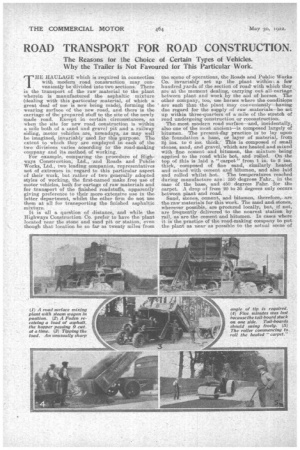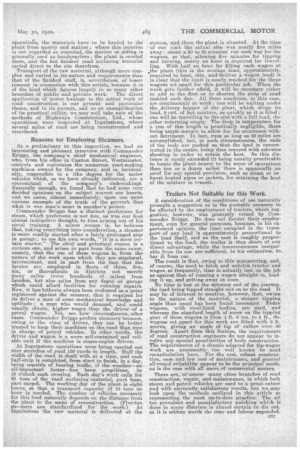ROAD TRANSPORT FOR ROAD CONSTRUCTION.
Page 24

Page 25

If you've noticed an error in this article please click here to report it so we can fix it.
The Reasons for the Choice of Certain Types of Vehicles. Why the Trailer is Not Favoured for This Particular Work.
THE HAULAGE which is required in connection with, modern road construction may conveniently be divided into twc sections. There is the transport of the raw material to the plant wherein is manufactured the asphaltic mixture (dealing with this particular material, of which a great deal of use is now being made), forming the wearing surface of the new road, and there is the carriage of the prepared stuff to the site of the newly made road. Except in certain circumstances, as when the site for new road construction is within a. mile both of a sand and gravel pit and a. railway siding, motor vehicles are, nowadays, as may well be imagined, invariably used for this purpose. The extent to which they are employed in each of the two divisions varies according to the road-making company and its method of working.
For example, comparing the procedure of Highways Construction, Ltd., 'and Roads and Public Works, Ltd., two leading companies, representatives not of extremes in regard to this particular aspect of their work, but rather of two generally adopted styles of working, the first-named make free use of motor vehicles, both for cartage of raw materials and for transport of the finished roadstuffs, apparently giving preference to their more extensive use in the latter department, whilst the other firm do not use them at all for transporting the finished asphaltic mixture.
It is all a question of distance, and while the Highways Construction Co. prefer to have the plant located near the stone and sand pit or station, even though that location be so far as twenty miles from
the scene of operations, the Roads and Public Works Co. invariably set up theplant within. a few hundred yards of the section of road with which they arc at the moment dealing, carrying out all cartage' between plant and work by the aid of horses. The other company, too use horses where the conditions are such that the plant may conveniently—having due regard for the supply of raw materials—be bet up within three-quarters of a mile of the stretch of road undergoing construction or reconstruction.
The most modern road surface—and, incidentally, also one of the most ancient—is composed largely of bitumen. The present-day practice is to lay upon the foundation a base, or layer of material, from 2i ins. to 6 ins. thick. This is composed of small stones, sand, and gravel, which are heated and mixed with fine cement and bitumen, the mixture being applied to the road while hot, and rolled. On the top of this is laid a "carpet" from 1 in. to 2 ins. thick, composed of fine sand, similarly heated and mixed with cement and bitumen, and also laid and rolled whilst hot. The temperatures reached during manufacture are: 350 degrees Fehr., in the case of the base, and 450 degrees Fahr. for the carpet. A drop of from 20 to 30 degrees only occurs between plant and road.
Sand, stones, cement, and bitumen, therefore,are the raw materials for this work. The sand and stones, wherever possible, are procured locally, but, if not, are frequently delivered to the nearest station by rail, as are the cement and bitumen. In cases where it is the practise of the road-making company to put . the plant as near as possible to the actual scene of operations, the materials have to be hauled to the plant from quarry and station • where this location is not regarded as essential, the station or siding i generally used as headquarters ; the plant is erected there,, and the hot finished road surfacing materia carted: direct to the site therefrom.
Transport of the raw material, although more coin p1ex and varied in its nature and requirements than that of the finished stuff, is, nevertheless, of lesser interest in connection with this article, because it is of the kind which figures largely in so many other
branches of public and private work. The direc application of motor haulage to the actual work e road construction is our present and particulai theme, and in its pursuit, and as an exemplification of its practical utility, we may even take note af the methods of Highways Construction, Ltd., whose operations were inspected at Ingateatones where several miles of road are being reconstructed and resurfaced.
Reasons tor Employing Steamers.
As a preliminary to this inspection, we had an interesting and pleaaant interview with Commandet 13riggs, the company's chief mechanical engineer, who, from i his office n Caxton Street, Westminster controls and maintains the numerous road-making machines owned by the company, and is, incidentally, responsible to a like degree for the motor vehicles which, as we have already indicated, are a concomitant of the company's undertakings. Naturally enough, we found that he had some very decided opinions on the subject nearest our hearts and we carne, almost immediately, upon one more curious example of the truth of the proverb the what is one man's meat is another's poison.
Commander Briggs has a distinct preference for steam, which preference is wet due, as was our firs almost instinctive thought, to bias arising out of hi naval training. A minor reason is, he believe that, taking everything into eousideration, a steamer is more readily started after a fairly prolonged stay in garage ; to use his own words, "it is a more cer tam n starter." The chief and principal reason is a curious erne, and arises in part from the same cause namely, that the use of these wagons, is, from the nature of the work upon which they are entployed intermittent, and in part from the fact that the lorries are employed in fleets of three, five, six, or thereabouts in districts not merely many miles (even hundreds of miles) from London, but also miles from any depot or garage Which could afford facilities for running repairs. Now, it has hitherto always been reckoned as a point registered against the etea,iner,. that it required for its driver a man of some mechanical knowledge and aptitude; a man who would demand, and could usually obtain, higher wages than the driveraof petrol wagon._ Yet, see howeircurnefances,aalter cases. Commander Briggs prefers steamers; because, owing to the class of driver, they can be better trusted to kee,p their machines on the road than men in charge of petrol vehicles. In other words, the driver and wagon is a, more self-contained and reliable unit if the machine is steam-engine driven.
At Ingatestone operations were being carried out over stretches of road 150 yards ill length. Half the width of the road is dealt with at a time, and each half-strip is completed, from start to finish, in a. day, being capable of hearing traffic, if the weather—an all-important factor—has been propitious, by 10 o'clock each evening. Each day's work calls for 80 tons of the road surfacinganaterial, part bane, part carpel. The working day of the plant is eight hours, so that a transport capacity of 10 tens an hour is needed. The number of vehicles necessary for this load naturally depends on the distance from the plant to the scene of reconstruction. (Five-ton t-imers are standardized for the work.) At Engatestone the raw material is delivered at the
station, and there the plant is situated. At the time of our visit the actual site was nearly five miles away ; about a 20 to 25 minutes' run -each way for the Wagons, so that, allowing five minutes for tipping and turning, nearly an hour is required for travel, ling. With half an hour for filling .each wagon at the plant (this is the average time, approximately, required to heat, mix, and•deliver a wagon load) it is clear that the limit is nearly reached -for the three wagons set apart for this particular job. When the work gets farther afield, it will be necessary either to add to the fleet or to shorten the strip of road tackled each day. All three machines, in this case, are continuously at work: One will be waiting under the delivery hopper of. the plant, which drops: its load, 9 cwt. of hot mixture, as quickly as it is filled ; one will be travelling to the site with a full toad, the other returning empty: The drop in temperature for a run of this length is practically negligible, there being ample margin to.allow for its occurrence without detriment. In fact, runs so long as 20 miles are accomplished, but, in such circumstances, the ends of the body a-re packed sothat the load is coneentrated in the centre, being then coyered with a,sbeetes sheeting in order to retain the heat. As this distance is rarely exceeded (it being usually practicable to locate the plant nearer to the scene of operations than ten or a dozen miles) there is apparently no need for any specie] provision, such as steam. or exhaust heated pipes or jackets, for retaining the heat of the mixture in transit. '
Trailers Not Suitable for this Work.
A consideration of the conditions of use naturally prompts a suggestion as to the probable economy to be effected by the employment of trailers, which suggestion, however, was promptly vetoed . by Commander Briggs. He does not favour their ent.pIoyment, even for general purposes, because, in his experienced opinion, the time occupied in the transport of any load is approximately proportional to the load itself, and as the cost, is roughly proportional to the road, the trailer is thus shorn of any
i direct advantage, while the inconveniences nseparable from its use are sufficient, in his estimation, to. bar it from use.
The result is that, owing to this manceuvring, and, of course, the need to hitch and unhitch tractor and wagon so frequently, time is actually lest on the job as against that of running a wagon straight in, loading it up, and getting away at once.
No time is lost at the delivery end of the journey, the load being tipped straight out on to the road. It may be of interest to mention, however, that, .owing to the nature of the material, a steeper tipping angle than usual has been found necessary. Foden wagons, with steel-lined bodies, are used, and whereee the standard length of screw on the tipping gear of these wagons is from 4 ft. 6 ins, to 5 ft., the wagons set apart for this work are fitted with 6 ft. screws, giving an angle of tip of rather over 40 degrees. Apart from this feature, the requirements of road construction engineers do not appear to involve any special peculiarities of body construction. The requirements of a chassis adapted far tip-wagon work are presumably too well known to need recapitulation here. For the rest, robust construction, ease and low cost of maintenance, and general all-round reliability appear to be the principal needs, as is the ease with all users of commercial motors.
There are, of-course many other branches of road construction, repair, and maintenance, in which both steam and petrol vehicles are used to a great extent and with eminently satiefactory results, but we may look upon the methods outlined in this article as representing the most up-to-date practice. The all too prevalent and unsatisfactory patching which is done in many districts is almost certain to die out, as it is seldom worth the time and labour expended.












































